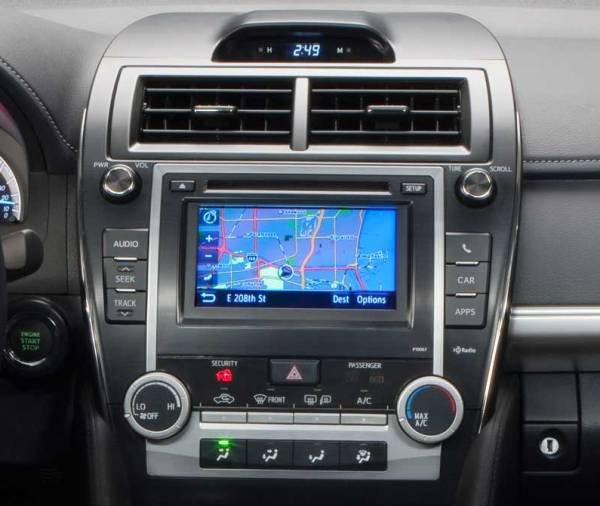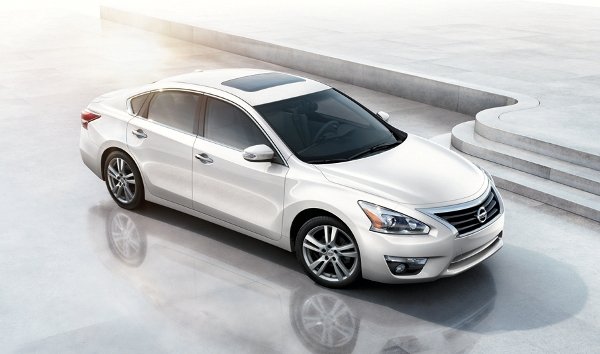Yes… I know it’s not electric
My day job is that of a trainer in the automotive industry. And seeing that I’ve just had an opportunity to drive around the 2013 Nissan Altima for a couple months, along with a couple of top competitors, I thought I’d pass along some of what I learned. The mid-size family sedan market is the most competitive in the industry, and easily sells the most vehicles. The Toyota Camry has been the number one selling automobile for quite some time now, while the previous generation Altima has moved into the number two slot. In this review, I’ll be covering the Altima, Camry and Hyundai Sonata, which was the third vehicle in our training mix. The Honda Accord was not included as it will be changing later this year. So let’s get to it.
Let’s start with the best selling Camry. Toyota introduced this seventh generation Camry late last year as a 2012 model to carry that torch forward. It still offers a four-cylinder model, which will make up the majority of Camry sales, and a V6 for those that want more power, status, and goodies. My neighbor, who is about to retire, just bought a new car and stated that he passed on the Camry because of its style. That spoke volumes to me. The biggest flaw that I see in this Camry is its dated design. The roofline is a carryover from days past, and the dash center stack seems too simplistic with its square buttons and square design.
 Power is decent, but handling suffers from typical Toyota soft suspension design – too much dive, squat and roll, depending upon what you are doing with your right foot and the steering wheel. Push button start, a standard feature on Altima, is only standard on the hybrid Camry and available optionally only on SE and XLE, but not the volume LE model.
Power is decent, but handling suffers from typical Toyota soft suspension design – too much dive, squat and roll, depending upon what you are doing with your right foot and the steering wheel. Push button start, a standard feature on Altima, is only standard on the hybrid Camry and available optionally only on SE and XLE, but not the volume LE model.
The Hyundai Sonata is in the middle of its build cycle, as the current good looking body design was introduced in 2010. Originally seen as the value contender of the bunch, the price has edged up into comparable territory when similarly equipped. Hyundai has chosen to eliminate the V6 from their choices, and replaced it with a 2.0 liter four cylinder turbocharged model. On paper the turbo looks stronger than its competitors, as it has more power and torque. The problem is that the four cylinder is smaller than what is found in the four cylinder Sonata (2.4 liter) so prior to spinning the turbo up to speed, it lags even its sibling. There is also a hesitation as the transmission looks for its lower gear ratio. However once spooled up, the turbo offers plenty of punch.
We had the upmarket version of each model – XLE V6 Camry, Limited 2.0 liter Turbo Sonata, and SL V6 Altima. As such, we had the best sound system that each make had to offer. The Sonata’s Infinity sound system would easily rock the house, as I discovered on a drive out to Yuma. The problem that I discovered along the way as I continued to turn up the good sounding system, was that at a certain volume level, the driver’s door and window started vibrating. Normally I wouldn’t listen at such volume levels, but what else is there to do when driving to Yuma? In this instance, the audio system proved to be more capable than the car it was installed in. A couple of other issues with the Hyundai – it took more effort to keep the car pointed in one direction while driving down the freeway as it tended to wander and road noise was easily the greatest of the three. Finally, rear headroom was tightest in the Hyundai. The Altima could stand improvement in this area, but fortunately, typically you will be riding in front. The Sonata does look good though.
Now to the Altima. The Altima uses an all new platform designed to offer improved ride quality with lower noise levels while maintaining its previous good handling. Toyota’s Camry was the low noise leader before, but I would have to say that the Altima has at least equaled the Camry in that respect.
Nissan has revised its 2.5 liter four cylinder engine to provide less weight, more power and lower emissions than before. When combined with the re-engineered continuously variable transmission (CVT) the Altima provides an amazing 38 highway miles per gallon. The significant portion of that improvement comes from the redesigned transmission. The range is now that of a conventional seven speed automatic. The advantage of the higher top speed ratio is better fuel economy, lower engine noise, and greater overall engine durability as a result of running at lower rpm. The benefit of a lower low gear ratio is improved acceleration. According to Car & Driver, the Altima is quicker than six competitors in the sprint from zero to sixty while offering better highway EPA fuel economy than any of them, including the Chevrolet Malibu Eco (37 mpg).
One complaint that many have offered up over the years about Nissan’s use of the CVT is its unusual operating characteristics. Due to the design of a CVT, it will offer up optimum performance or optimum fuel economy, depending upon what you are doing with your right foot. Most conservative drivers only notice an extremely smooth driving experience. But those with a right foot that tends to use more of the gas pedal range than the rest of us would quite often complain about the experience. A CVT does not feel like a “normal” transmission when driving briskly. Nissan has been quietly addressing this with a Sport mode on many of their CVT equipped vehicles.
When in Drive mode, a CVT equipped vehicle accelerated aggressively will run the engine up to optimum rpm and hold it there. As most cars run past that point and shift up to the next gear repeating that sequence until the desired speed is reached, the CVT feels unnatural. While offering other benefits, the Sport mode of Nissan’s Xtronic CVT simulates a conventional transmission when being driven with a heavy foot, simulating shifts between gears. Nissan used to offer a manual shift mode (which generally never got used anyway) in the Altima. Paddle shifters are still included on the V6. But the new Sport mode will make those lead-foots feel more comfortable when whizzing around town. The Sport mode CVT can also be had in the Maxima, Juke and Rogue if you happen to be looking at those classes of vehicles.
As mentioned, the Altima offers standard push button start which is an extra cost item in either the Toyota or Hyundai. In addition, the Altima this year offers standard Bluetooth – a very desirable feature, also standard on the Sonata, but not available on the Camry L. In addition, standard Bluetooth streaming audio is available in all Altima models. We have found this to be one of the most desirable features as many drivers have moved their music collections into their phones.
Finally, the Altima offers up some pretty upscale safety features such as lane departure warning and moving object detection (for those pedestrians that you can’t see walking through the parking lot at the grocery store because of that giant SUV next to you). These two technologies are typically found on much more expensive vehicles. Only available on the top line SL model when equipped with the Technology package, these features along with blind spot warning are still very affordable when compared to other makes that offer them.
I’ve said for years that nobody builds a perfect car. What works for me, may not work for you. I still say that. But if you’re looking for a mid-sized family sedan, you would do well to include the Altima in the mix.



I have a.black on black altima and i enjoy it runs great by the way it’s a 2013 model and the fuel pump miss me alot. If you have any doubt about this car just try it out guaranteed you’ll be satisfied
Carlos – Welcome to Living LEAF. Thanks for your feedback on the 2013 Altima. We too feel that it is a great value in the segment.